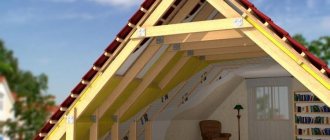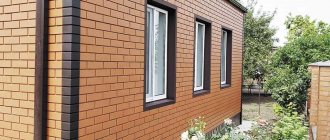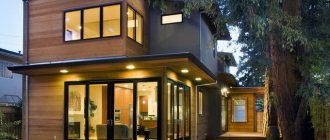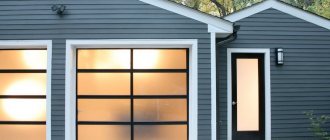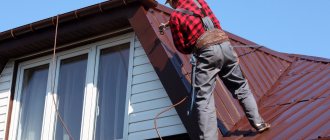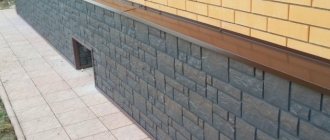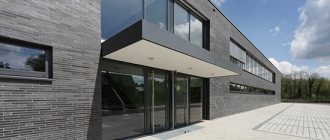For many, flat roofing is associated with urban multi-story buildings, faceless and monotonous. But we are ready to surprise you! A flat roof in a private house will be a pleasant discovery for you if there is not much snow in your area, but the winds are quite strong. The fact is that in winter all snow accumulations from such a roof will simply be blown away. And the main thing is that not a single strong hurricane can tear off a roof that simply does not exist! And a whole ocean of possibilities opens up before you, which you can now build above your head: a cafe, a dance floor, a mini-garden and even a whole greenhouse!
The main thing is to know about all the intricacies of constructing houses with a flat roof, and everything will work out. And now we will reveal all the secrets.
Pros and cons of this design
Here are the main advantages of installing a flat roof for a private home:
- Such a roof is much smaller in area than the most gently sloping roof. And this means savings on materials.
- Such a roof is built much faster than a gable roof, and even more so a hip roof.
- Comfort and safety of all rafter work. You still have to manage to fall from such a roof!
- Convenient subsequent repairs and replacement of roofing.
- Unlike a gable roof, dismantling the old flat roofing is usually not necessary - this is additional waterproofing and protection. The new pie is made directly from the old one, which saves a lot of time and effort.
- The ability to use the roof as an additional useful area where you can plant a flower garden, make an open terrace and even build a greenhouse.
- The ability to install transparent roof elements (with careful waterproofing), and thus create a view of the night sky.
- Opportunity to build a house with a laconic architectural form. Minimalism is at the peak of fashion!
And now – about the pros and cons:
- Such a roof generously accumulates snow. After all, he now has nowhere to slide, and the snow itself often becomes the cause of leaks.
- On especially generous days, the snow will have to be removed mechanically, which often damages the roofing.
- The structure of the roof becomes more complicated: now we need gutters, which also become clogged.
- The difference is that water drains from a pitched roof quite quickly (and sometimes it does get into the under-roof space). But on a flat one it actually stands! Monitoring the moisture content of the insulation and the general condition of the roof should be regular.
- But, despite the fact that much less building materials are needed for its arrangement than for a pitched roof, a flat roof is much more complex in terms of installation. Let's just say that there are many more different subtleties and nuances that are important to know about.
That is why many have fair doubts about the reliability of such a roof. But the European and overseas experience of private residential buildings with a flat roof is successful, and therefore you can safely get down to business.
Just consider these points:
- There is much more snow in Russia than in warmer European countries.
- The only thing worse than snow is the large difference between summer and winter temperatures, which not all foreign roofing materials are designed for.
And here technology decides everything!
Examples of private houses
There are many supporters of flat roofs among developers. They are attracted by the ease of construction, low cost of work and the possibility of placing a site for summer recreation.
We recommend reading: How to make a pitched roof for a house extension with your own hands - step-by-step video, photo
A thick layer of snow on a flat roof is not a problem, but additional insulation
The design of buildings with such a roof fits perfectly into the style of minimalism, providing project developers with a wide field for creativity.
Spacious, comfortable and nothing superfluous is the motto of everyone who chooses a house with such a roof. A pitched roof visually weighs down the building, while a flat roof, on the contrary, makes it light and airy.
The appearance of the facade of a one-story house with a flat roof compares favorably with the rather boring variations of the “teremkovy” character.
On it, most often you will not see gutters and pipes, the water from which gets on the walls and spoils the appearance of the finish. Internal drainage is efficient, practical and invisible.
What is a flat roof?
So, what acts as the load-bearing base of a flat roof:
- Reinforced concrete slab.
- Roofing sandwich panels.
- Reinforced steel corrugated sheet.
And thanks to the fact that they learned to make a flat roof “breathable”, i.e. with internal ventilation, it has now become possible to use completely non-breathable waterproofing - roofing felt similar to it.
Any roof that we call flat actually still has a slight slope: to one side or specifically towards the drainpipe.
Here is the simplest example of a flat roof for a private home:
How to cover a flat roof
The material for covering a flat roof is selected based on its purpose.
Unused surfaces are most often covered with roofing felt and the joints are sealed with liquid bitumen.
Recently, a large number of similar materials have appeared with improved characteristics that make it possible to more reliably protect the roofing pie.
Operated surfaces require a more rigid and durable coating . At the same time, the task of hermetically sealing the insulation from external influences is not removed, so most often a sand-cement cushion and a working layer - paving slabs - are laid on top of the soft roof.
Coating
Types of flat roofing: non-exploitable and inverted
Of course, unused roofs are cheaper. And the exploited ones, which are correctly called “inversion”, include additional materials.
A separate type of flat roof of a residential building is exploitable. Those. the one on which people will walk and what objects will stand. This is the same garden, or sports ground, or summer cafe. All this creates considerable loads on the roof, and therefore its design is already different from that which is intended only to protect the house from precipitation.
So, the main difference in the design of traditional and inversion roofing is that in the first, the thermal insulation layer is located under the waterproofing, which is quite logical, and in the second, it is above it. But in the second option, the waterproofing is more protected from ultraviolet rays and temperature changes. This design is more durable and functional: you can safely lay out a lawn or lay paving slabs on it.
And now in more detail.
Unused roof: standard pie
But a person can also occasionally climb onto an unused roof - for the same repairs, for example.
Those. in a traditional flat roof, the top layer is waterproofing, and it is this that is exposed to all mechanical and temperature loads.
A separate type of it is a roof with a pressure layer, which is designed so that a person can walk on it from time to time:
Inversion roofing: reverse pie
The standard slope of an inversion roof is 5-7%. The inversion method assumes that the thermal insulation layer is already placed on top of the waterproofing, which now also serves as a vapor barrier.
Moreover, the pie of inversion flat roofs can be very different. It all depends on what you are going to arrange on the roof: a terrace, a mini-pool (and this is not uncommon) or a garden. But the base will still be common: a monolithic screed is made, which levels the entire surface, then waterproofing is laid and the whole thing is covered with insulation. And on top is a cement-sand mixture or rubber coating.
Note that active use of the roof means frequent damage to the insulating layer, which is why moisture makes its way to the insulation and freezes in winter. Over time, the entire roofing pie deteriorates, and therefore a flat roof cannot do without a ventilation system.
A cement-sand screed can even better distribute the pressure layer on the heat insulator, but it must be additionally reinforced with a mesh to prevent cracking.
How to build step by step?
Common to all types of flat roofs is often a load-bearing base. It can be reinforced concrete slabs or a monolithic reinforced slab. For small buildings, the base of the roof can be wooden floors .
When installing a flat roof on a private house, the procedure for a heated building, discussed above, is familiar. To illustrate the process, consider an example of installing a flat roof for a small residential building with brick walls.
- The upper surface of the masonry walls is leveled with cement mortar.
- To withstand a roof slope of 30, the height difference between opposite walls is maintained based on the rise of each linear meter of roof by 30 mm. This can be done with rows of brickwork or by laying 300-gauge steel channel on one of the opposite walls.
- The rafter beams are laid.
- A flooring made of boards, construction plywood or other durable sheet material is installed on top of the rafters.
- The surface of the roof base is covered with waterproofing.
- Thermal insulation is installed, usually a backfill insulation, which is reinforced with a concrete screed.
- After the concrete screed has dried, a bitumen-based primer is applied to it.
- The final roofing covering is laid. For inversion structures, choose a surface that is comfortable for walking on. This could be paving slabs, asphalt, cement screed or ceramics. For traditional flat roofs, roofing felt is most often used. Spray roofing is rarely used.
- If the roof is built with parapets, then spillway funnels are installed at its corners. Otherwise, a galvanized steel gutter is hung from the underside of the roof with a slope to the drain pipe funnel.
How to make roofing units?
The main components of a flat roof are the junction, the overhang and the passage through the roof.
The arrangement of the units is carried out on a reinforced concrete base in areas where the cut of the pie is adjacent to the vertical structures . The main requirement for the units is to ensure the tightness of the joint and its thermal protection.
Roofing assemblies also include places where chimneys, ventilation pipes or other communications extend outside the flat roof. Openings are made in the roofs for them. Special galvanized steel aprons with rubberized gaskets are installed around the pipes.
Subtleties of flat roof insulation
A layer of thermal insulation for a flat roof is mandatory. For comparison: a gable roof is insulated only when a residential attic is installed underneath it, and in all other cases, a maximum of mineral wool is laid on the attic floor. But for a flat roof, insulation is always necessary.
The fact is that without a heat-insulating layer in a flat roof, condensation will constantly appear on the ceiling in the house (such a roof will turn out to be the cold part on which water vapor will rush). And this is bad not only because repairs will have to be made, but also because the entire structure deteriorates.
You can insulate a flat roof both from the outside and from the inside - the difference is small. What is more important is how many layers of insulation a particular roof needs – one or two.
Thermal insulation materials must be attached to the base of the roof mechanically, either with screws or dowels, or with adhesive. Sometimes the fastening is not used at all if the heat insulator is located outside and paving slabs or pebbles press on it.
Why two layers? The fact is that the first layer of thermal insulation on a flat roof acts as insulation; it is from 70 to 200 mm thick. And the second, from 40 to 50 mm, is designed to distribute all the loads. And it is important to calculate the thickness of both layers accurately, based on the climatic characteristics of the area and the future use of the roof itself.
With double-layer insulation, all joints should be spaced apart, in a checkerboard pattern, so as not to overlap each other. Moreover, in the places where the slabs adjoin the walls and parapet, it is additionally necessary to make heat-insulating sides. A cement-sand screed can even better distribute the pressure layer on the heat insulator, but it must be additionally reinforced with a mesh to prevent cracking.
Mistakes when building a roof with your own hands
- Lack of project . When building the roof of a house with your own hands, without a project, it will not be possible to create a reliable and safe structure, since without the appropriate documentation it is impossible to assess the stability of the structure, find out the permissible loads and cross-sections of rafter legs, fix node connections and fastening points, calculate the amount of materials, etc.
- Incorrect roof covering . For example, roofs made of ceramic tiles and slate should be laid only with sufficiently large slopes, while soft materials, on the contrary, require a flat roof, since otherwise the integrity of the structure may be at risk.
- Loose fit of thermal insulation . If blocks with thermal insulation materials do not fit tightly together, this will lead to the formation of cold bridges, which in turn contribute to the accumulation of condensation and the appearance of mold/mildew.
- Absence/incorrect installation of vapor barrier . The absence of a vapor barrier membrane on the inside of the roofing pie leads to the accumulation of dampness in the thermal insulation and wood, as a result of which the materials lose their performance qualities. It is also necessary to ensure that the membrane is laid on the correct side.
- Lack of ventilation . It also leads to condensation and dampness with corresponding consequences. To create optimal under-roof air circulation, it is necessary to use a counter-lattice.
- Poor sealing . Poor quality sealing can lead to damage to the integrity of the entire structure. However, due to negligence, the joints are often insufficiently treated, the sealing tape is glued directly to the dirty surface of the hydro- or vapor barrier, and fasteners without a sealing washer are used to install the roof.
- Inappropriate savings on materials . The roof is one of the most difficult structures to erect, which protects all other elements of the structure. If you want all this to serve in good condition for many years, you cannot skimp on both roofing materials and all accessories - membranes, tapes, fasteners. Otherwise, irrational savings can lead to expensive repairs in the near future.
Proper drainage system
But this is already a difficult task. Flat roofs are just bad because they are completely open to rain. But everything can be solved! The main thing is to properly organize the drainage, and for convenience, we have explained this issue for you in the following schematic illustrations:
Installation
A flat roof cannot be installed strictly horizontally - a minimum slope of at least 5 degrees must be observed. This requirement is due to the need to ensure the drainage of rainwater and snow from the roofing surface. Another important point: it is necessary that the slope be created not only by the coating, but mainly due to the correct execution of expanded clay or slag bedding. Even if the slope angle reaches 10 degrees, this will not interfere with the uniform laying of the heat-insulating material.
Internal ventilation device
Another important point when arranging flat roofs is ventilation. The fact is that if moisture accidentally gets into the insulation, it no longer evaporates - it only accumulates. As a result, the heat-insulating material rots and the waterproofing swells. And there are many reasons for leaks: damaged waterproofing, mechanical damage to the top layer of the roof, cracks and damage from frozen water.
A wet thermal insulator is also bad because it causes bubbles and cracks to appear on a flat roof in the summer heat - all due to the active evaporation of water. As a result, the roof covering also collapses. And if moisture gets under the old screed over time, then the entire roof begins to peel off. This is why a flat roof must “breathe”.
For this purpose, so-called aerators are used. They look like simple plastic or metal pipes covered with umbrella caps. They should be located evenly over the entire roof area, preferably at its highest points. The essence of this mechanism is that different pressures are created inside the roof and the air begins to create currents, simultaneously taking with it all the excess moisture vapor.
In practice it looks like this:
In addition, in any living space, water vapor rises up to the ceiling. Moreover, they often successfully overcome this barrier (the water molecule is very small) and end up in the insulation, which is bad for it. This is why vapor barrier is required. And not the kind that is usually used for attic insulation, but a dense one, made of high-quality polypropylene or polyethylene. The bitumen membrane is even more reliable.
Types of flat roofs
There are four main types of flat structures:
Operated roofs
Their peculiarity is the need to create a rigid base - otherwise it will not be possible to maintain the integrity of the waterproofing layer. The base is a screed based on concrete or corrugated sheeting, which is necessary to create a certain slope for water drainage. The thermal insulation material used in constructing the roof in use will be subject to significant static and dynamic loads and must have a sufficient level of compressive strength. If the insulation is not very rigid, a cement screed will be required on top.
Unused roofs
When installing this type, there is no need to create a rigid base in order to lay waterproofing material. No need for rigid insulation. For further maintenance of the roof, bridges or ladders are installed, the function of which is to evenly distribute loads over the roofing surface. The construction of unused flat roofs will cost much less, but they will not last as long as exploited ones.
Traditional roofs
The structure of traditional types of roofs involves the placement of a layer of waterproofing material above the thermal insulation material. The base for the roof is a reinforced concrete slab, and water is drained from the roofing surface by creating an inclined screed made of expanded clay concrete.
Inversion roofs
Inversion type roofs have practically solved the problem of leaks - the main drawback of flat structures. In them, the thermal insulation is located above the waterproofing carpet, and not under it. This technique helps protect the layer of waterproofing material from the destructive effects of solar ultraviolet radiation, sudden temperature fluctuations, the process of freezing and subsequent thawing.
Compared to other types of roofing, inversion roofing is more durable.
In addition, it is distinguished by increased functionality: you can lay a lawn on it and make tiled laying. The optimal angle of inclination of such roofs is considered to be from 3 to 5 degrees.
Choosing a suitable roofing covering
So, what is used as a coating for such roofs?
Option #1 - bitumen and polymer-bitumen materials
Such roofs are the least expensive for owners of private houses. We are mainly talking about roofing felt and euroroofing felt. These are rolled roofing sheets, the base of which is synthetic fabric, and the sides are bitumen. As an elastic and frost-resistant material, bitumen serves as excellent protection and waterproofing.
Moreover, laying bitumen roofing on a flat roof is absolutely simple; you only need a gas burner. The rolls are easily fused together.
But such a roof has a significant drawback - fragility. And another thing is that roofing felt does not breathe at all, i.e. It is vapor-tight, and therefore it is necessary to arrange ventilation for such a roof, unless you want the insulation to rot within a year:
Option #2 - liquid rubber
Such roofs have the great advantage that they do not contain any seams. As we have already said, the disadvantage of a flat roof is, first of all, that snow accumulates on it, which then causes leaks.
But there are some subtleties here. So, you need to take only two-component liquid rubber for a flat roof, preferably the highest quality one. And it is extremely important to apply this material correctly to a flat roof: evenly, avoiding unnecessary layers and saving in certain places. So, where the paint was applied unevenly, problems should be expected within 8-10 years.
Option #3 - PVC, TPO and EPDM membranes
Roofing membranes are valuable as a covering for flat roofs because they allow steam to escape. After all, no matter what kind of vapor barrier is used, moisture still, at least a little, gets into the insulation, not only from below, but also from above - after heavy rains, for example.
There are three types of membranes for installing such a roof: TPO, PVC and EPDM. The most popular is PVC membrane, which is also the most flammable. An EPDM membrane is more durable and affordable, but if mechanical damage occurs in it, nothing can be done to fix it, whereas a PVC membrane can only be melted with a hairdryer. In addition, the joints of the EPDM membrane must be glued with a special tape, which is much less reliable than soldering PVC sheets.
But the cheapest membrane in its sector is PVC. But it has such significant disadvantages as low resistance to ultraviolet rays and fear of contact with bitumen, various oils and even polystyrene foam, otherwise the service life will be significantly reduced.
Gluing EPDM membranes requires professional skills. TPO membrane, like PVC, is also welded with hot air. The best is not afraid of ultraviolet radiation, is more chemically resistant and can be laid directly on polystyrene foam or an old bitumen roof without geotextiles. But its service life is shorter than that of EPDM, so for installing a flat roof on a residential private house, we recommend using a PVC membrane.
So, a flat roof device with a PVC membrane is traditionally made like this:
- Step 1. We arrange a monolithic floor slab.
- Step 2. Place a tear-resistant vapor barrier film.
- Step 3. We make a bend from insulation or screed.
- Step 4. Place insulation. In private construction, this is usually 35-density foam, and on top is 50 mm XPS, which is even stronger.
- Step 5. Now geotextiles, 300-500 g per square meter.
- Step 6. Let's move on to waterproofing - this is a PVC membrane. The insulation density is enough to allow walking on such a roof. But, if you plan to make an open terrace on the roof, then you need to continue the pie further.
- Step 7. Lay the geotextile again - now directly on the membrane. We lay rubber tiles or reinforced screed 5-7 cm, on which we already lay paving slabs. To make a screed, you need ballast.
And such roofs are made of rubber, polymers or even foil. Unlike bitumen, they are durable, fire-resistant and adhere firmly to the base. A slight slope is achieved using expanded clay concrete or concrete screed.
Roofing materials
Any flat roofs are covered with roll, membrane or mastic materials. This is when it comes to basic waterproofing. Rolled materials are glued or fused to the base, all joints are carefully sealed. Depending on the base, the material can be laid with a loose carpet, followed by loading with gravel or other materials.
The membrane is in its original state also a roll of polymer materials, usually PVC or ethylene-propylene rubber - EPDM. Membrane waterproofing is different in that the joints between adjacent strips are not glued, but welded. This produces tight and strong seams that join the sheets into a single membrane that covers the entire roof without any weak points.
Mastic is a special composition that, in a liquid state, is applied to the base in several layers, thus forming a continuous, seamless waterproof layer.
In addition to waterproofing, other materials are used that give the roof the desired characteristics. When choosing what to cover a flat roof of a house with, you need to take into account its design, method of use and climatic conditions.
How to achieve 100% waterproofing?
The main task when installing a flat roof is to make all joints and junctions as airtight as possible. After all, such a roof is most affected by moisture, hail, temperature changes and wind-blown debris. Therefore, the sealants used to seal such joints must be of high quality and resistant to any influences. This is also a kind of expense that has to be incurred.
For the same purpose of waterproofing, it is recommended to make the slope of a flat roof at least 2%. Few? In fact, this is quite enough so that all atmospheric moisture does not linger on the surface, but flows down into funnels and pipes, and from them into the septic tank, soil or sewerage system. Therefore, even at the design stage, you need to carefully think through the future drainage system.
Moreover, the drainage system itself is made both internal and external. Thus, internal drainage is made up of fittings - funnels located throughout the roof, which receive the flowing water and direct it into pipes that go through the buildings, but are isolated from the living quarters. The only disadvantage of such a system is that the pipes become clogged with small debris and leaves, for which it is advisable to equip them with special filters and periodically clean them.
External drainage systems are already attached to the outer walls of the building. These are, of course, easier to clean when they become clogged, but in cold weather they often freeze over. For this reason, it is customary to additionally supply them with electrical heating in the form of cables.
As for the material for the internal and external drainage system of a flat roof, PVC or metal is quite suitable. Both options have their pros and cons. Thus, polyvinyl chloride does not corrode, but is more brittle than metal.
To prevent gutters from freezing in winter, equip them with roofing thermal cables.
Methods for constructing flat structures
There are several main ways to create flat roofs:
- By installing concrete floor slabs. Such work can be completed in a fairly short time, but special lifting equipment will be required. The use of this method involves the implementation of insulation. The material can be laid both inside and outside.
- Using metal channels or I-beams, on top of which it is necessary to lay boards: their thickness should be 25-40 mm. A layer of expanded clay is poured on top, then a concrete screed is created.
- The creation of the ceiling is carried out through monolithic concreting. This requires high-strength formwork with thick supports. The supports are fastened together using jumpers. This type of floor also needs to be insulated.
- Using large ceramic blocks: they are laid on top of metal beams. Such blocks replace wooden flooring. The main advantage of this method is the use of ceramics, which is characterized by increased mechanical strength, resistance to moisture and excellent sound and heat insulation properties. Large ceramic blocks do not require additional insulation: when using them, you can limit yourself to such a measure as creating a concrete screed.
Green area on the roof: fashionable and environmentally friendly
Greenery and recreation areas are often lacking not only for residents of the “concrete jungle”, but even for owners of private houses. The thing is that it is not always possible to leave the same beautiful garden furniture in the yard of the house, and beautiful rare flowers in the garden flower bed are often trampled by pets. Therefore, it is not surprising that the green area on the roof has become fashionable among cottage owners. Especially if the access to it comes directly from the bedroom and no one else can disturb your morning peace with a cup of coffee.
There has also become a fashion for some cafes to make the roof flat and put a small greenhouse on it. All the greens go straight to the table! And it’s profitable, because it’s not so easy to bring fresh dill or onions to the kitchen, and it’s economically profitable - there’s somewhere to send kitchen waste. And it is difficult to understand who borrowed this idea from whom: enterprising residents of private houses with a flat roof, or the best minds in public catering. But the fact that such an arrangement of closed ground is beneficial is a fact: rodents will not dig under the beds, insects and pests will not reach (as well as pests in the form of neighbors), and the fact that it is always a little hotter on the roof is only a plus for the same tomatoes. But the main thing is to correctly calculate the loads on such a roof during construction!
And the roofing pie is often standard: waterproofing for the ceiling, thermal insulation, geotextiles, drainage and geotextiles again. And on top you can use both soil and beds:
Or in this version for more powerful floors:
A flat roof is a huge scope for any imagination. Designers and architects love to bring to life a variety of projects for her: a garden, a greenhouse, a jogging track, a mini-beach with sun loungers, and much more. Some craftsmen even manage to make a parking lot on it!
Types of construction
Before considering the advantages and disadvantages of a house with a flat roof, let's understand the types and subtypes of this type of roof.
Exploited
This is a type of flat roof that provides for the installation of any equipment or the use of this area for other needs:
- Construction of flower beds, lawns or recreation areas.
- Construction of a greenhouse or winter garden.
- Sports and children's playgrounds.
- It is possible to organize parking or a swimming pool.
The main condition is that the strength of the floors and load-bearing walls matches the load provided by the roof being used. In addition, you need to be 100% confident in the reliability of the waterproofing layer, since covering it is quite problematic.
Unexploited
This is a type of flat roof that provides only emergency access to the roof for carrying out any work and servicing the equipment located there. On such a flat roof there is only snow. Precipitation is a determining factor in choosing the type of roof. If a large amount of snow falls in the region, then in most cases you can simply forget about the roof being used. There are differences based on design features.
No attic space
This roofing provides for the absence of any space between the roof surface and the ceiling of the interior. In this case, it is necessary to pay special attention to waterproofing. The snow will melt from the heat in the house.
With attic space
Such a flat roof provides space between the ceiling of the top floor and the roof itself. In this case, special thermal insulation is not required, as is close care of the roof itself.
According to the type of arrangement of the roofing pie, subtypes of flat roofs are distinguished.
- Traditional. This roof involves the initial installation of a thermal insulation layer, after which waterproofing is laid.
- Inversion roof type. In this case, everything happens the other way around. First, the waterproofing is laid, then the thermal insulation boards are laid.
Uses and modern designs with photos
Modern technologies and materials make it possible to cover even a frame house with a flat roof, heavier than a traditional pitched one (a comparison of flat and pitched roofs can be found here).
Examples of flat roofs in private housing construction:
For buildings and structures, only monolithic reinforced concrete foundations are used . Such roofs offer more possibilities for use.
Examples of flat roofs of buildings and structures:
Advantages and disadvantages
A flat roof can be used as an additional place to relax.
The first advantage of using it is cost-effectiveness. A pitched roof of a simple gable structure requires more construction costs than a flat roof. For hip or tent structures, do not use cheap rolled materials, which are used when constructing flat types. A decrease in slope leads to a decrease in coverage area.
Installation advantage:
- Ease of installation and speed of work. Materials are quickly laid out despite the large area. Specialists without a high degree of qualification can fuse rolled building materials.
- Possibility of use in high-rise buildings. Increasing the number of floors leads to an increase in the wind load acting on the top covering. For tall houses it is not recommended to make pitched roofs, because... you will have to increase the massiveness of the foundation.
- Rational use of roof space. The surface is used for creating recreation areas, gardens, and installing solar panels.
The correct choice of material and adherence to flat roof construction technology are required, because... mistakes lead to premature destruction of the flooring and frequent repairs. During snowfall, high sediments form, which melt and threaten additional leaks in weak spots.
